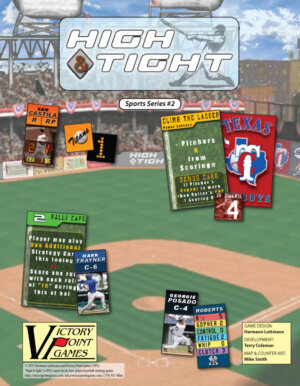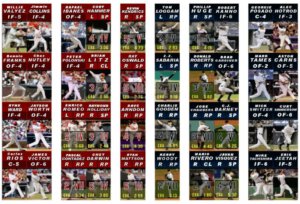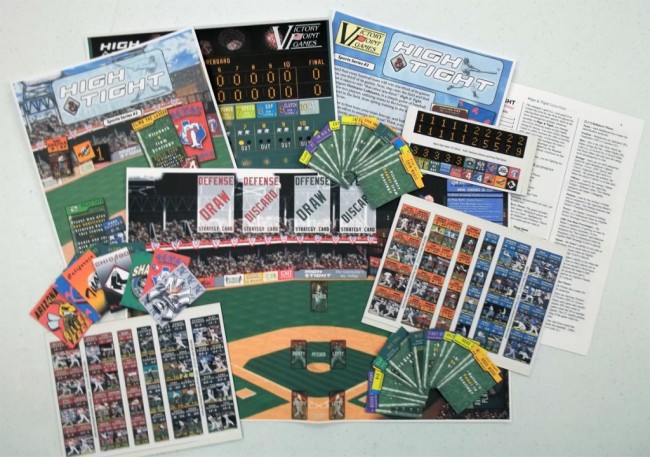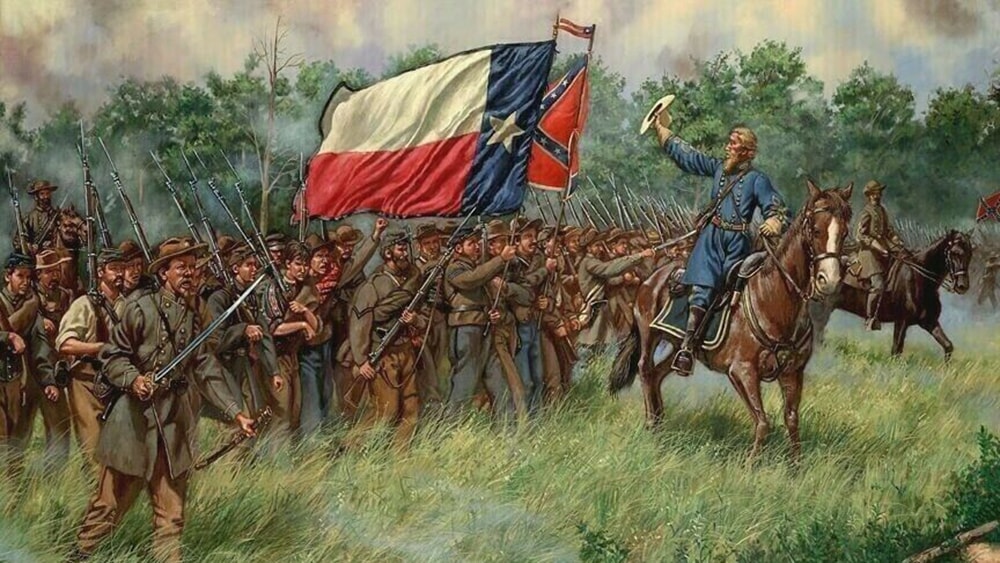
Publisher: Victory Point Games
Designer: Hermann Luttmann
Year: 2011
Players: Two players
Ages: 10+
Playing Time: 45 Minutes
Genre: Card based baseball game
MSRP: $33.95
I’ll begin this review my pointing out High and Tight is a complete departure from what many may consider a traditional head-to-head baseball game. Those who enjoy the hard numbers and simulation as found in Strat-O-Matic, APBA, or other such baseball games will find much of the action on the field extremely abstracted here. On the other hand, light gamers who enjoy just a quick card flipping or, dare I say, spinner style basic game may find there’s a bit too much under the hood of High and Tight.
Yet, for fans of America’s Pastime who want a quick playing game which gives a good feel for baseball and produces realistic scores based upon the players on the field, High and Tight may just strike the right chord.
The game is designed for two players – honestly, I can’t see playing solo as the action cards would make things a bit tricky – who each field one of the four included teams. Fielders are broken down by type such as infielder, outfielder, or catcher and rated in six categories: Offense, Power, On Base Percentage, Speed, Clutch, and Defense. Pitchers are either starters, relievers, or closers and rated in eight categories: Strikeouts, Gopher Balls, Fatigue, WHIP, Clutch, Scoring Roll, and Scoring Number. So far this might all sound like standard stuff for those who play stat based sports games but there’s a big twist…

Your team must field a line-up including one catcher, three outfielders, four infielders, and a DH. Yes, even National League teams field a DH… Being a Cubs fan, I’m not thrilled with a designated hitter being included in NL line-ups but I’m sure a basic pitcher’s hitting chit could be devised. Of course that means one inning will have a miniscule chance of runs being scored for the offense but I, for one, would be happy with that trade off.
Runs are scored by simple die rolls. When your pitcher takes the mound you’ll set up his “Stuff” on the tracks on the game board. “Stuff” is the Scoring Roll and Scoring Number on the pitcher’s chit. Suppose Tim Lincum of the California Titans is on the mound. His Scoring Roll is a two while his Scoring Number is a VII. This means that normally the batter would get to roll twice looking to roll exactly a seven on two six sided dice in order to score a run. If you rolled a seven both times, you’d score two runs! There’s also a “mano a mano’ aspect to the game as the batter’s Offense is adjusted by the fielder’s Defense as the Defense is subtracted from the Offense.

Let’s put this all together…
Say you’re the player managing the Texas Cowboys, at home in the fifth inning against the aforementioned California Titans. Your starter A.J. Pilson is on the mound with his rating of 2/VII – normally meaning two rolls needing a seven to score a run on either roll. The fifth is a Power inning so you decide to keep Pilson on the mound (he’s been putting goose eggs on the board) and bring in Jack Hampton as your fielder. Your opponent decides he’ll bring Pat Burl to the plate. Sure this would have also been a good spot to have Buster Posse but he was used in the fourth – a Clutch inning.
Burl’s Offense is a five while Hampton’s Defense is a four. The difference is positive one so you move the Scoring Number up one, to a VIII. This means the batter will get two rolls, needing either a two or a seven to score a run. Now the Strategy Cards come into play. The Titans player doesn’t have any Offense cards that are either Power or Special so he can’t play a card. You, on the other hand, have the Power card “Chin Music” in your hand so you play it. This card subtracts the pitcher’s Gopher rating from the Scoring Number. Making that adjustment, the Scoring Number is now a V so the titans still get their two rolls but now only a five will score a run. The Titans roll a six and a seven. How lucky for you! If you hadn’t played “Chin Music” the Titans would have scored a run with that seven.
Pilson retires the side with another zero on the board.
Into the bottom of the fifth, you have Hampton at the plate since he was the fielder in top of the inning. Burl is in the field because he was the batter. Lincum is the Titans pitcher and we already know he’s a 2/VII. Just as Pilson before, this means two rolls with sevens scoring runs. Hampton’s Offense is six while Burl’s Defense is pretty poor at a three. That’s positive three for Hampton so the Scoring Number moves to an X: runs scored on fours and sevens. It’s time to take advantage of the “Good Wood” Power card that’s been sitting in your hand so you play it. This card adds the batter’s Power rating to the scoring number. Nothing has changed since the top of the fifth so the Titans can’t play a power or Special card to counter. Hampton’s Power is a three but the maximum Scoring Number is XII so the adjustment is really only two but you now have the best rolls to score runs: six and sevens. You roll twice and get seven and six. Woohoo!!! Hampton’s Power has helped the Cowboys break through against the Titan’s ace with two runs!

In playing High and Tight you can see where the influences of other sports games come into play. Hermann Luttman has already stated that he wanted to create something along the lines of Slap Shot or the old Avalon Hill title Pennant Race and it certainly shows. Gameplay is quick enough where you can cruise through a World Series in an evening while still having an overall narrative of each game – Boy, that Jack Hampton sure put on a show! No wonder he won the Series MVP!
All is not perfect with High and Tight though and while these aren’t necessarily criticisms of the game design itself, they do bear mentioning. First, as I’ve mentioned, as a fan of the National League I’m not thrilled with all teams using a DH. Also there are only four teams included with the game. Plus, the release date of the game was a bit questionable. Honestly, Hermann had two other designs in the hopper at the time we originally talked about High and Tight back at CSWE so I’m taking a stab that VPG wanted to release the two other titles (Dawn of the Zeds and Gettysburg: The Wheatfield) first because they’re most likely more appealing to VPG’s core audience. Still having a game come out with playoff teams from 2010 a few weeks after the completion of the 2011 season does strike me as a wee bit odd.
In the end, I might not be the sort of baseball gamer that High and Tight is aimed at – I play a lot of Out of the Park Baseball on the PC and just may have had every stat-head baseball game in my collection over the years – but I still can appreciate the thinking outside the batter’s box that went into the design. You really do feel like you’ve been playing a baseball game when you’re done and the scores are realistic overall; there’s nothing worse than a baseball game consistently producing football scores! If you wanted a 21-17 score then wouldn’t you just whip out a football game?

[rwp-review id=”0″]


















